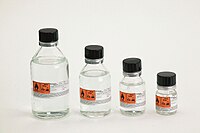
Photo from wikipedia
Reduced nucleophilicities ИB of axially symmetric molecules B were determined from 𝐷e/𝜎min=(𝑁B/𝜎min)𝐸XY= ИB𝐸XY, where De is the equilibrium dissociation energy of the complexes BΛXY, NB is the nucleophilicity of B… Click to show full abstract
Reduced nucleophilicities ИB of axially symmetric molecules B were determined from 𝐷e/𝜎min=(𝑁B/𝜎min)𝐸XY= ИB𝐸XY, where De is the equilibrium dissociation energy of the complexes BΛXY, NB is the nucleophilicity of B and EXY is the electrophilicity of the halogen-bond donor XY. De was calculated ab initio at the CCSD(T)-F12c/cc-pVDZ-F12 level. The series BΛClY, BΛBrY, BΛIY (Y = F, Cl, Br, I, CN and CCH) as well as (BΛXY, XY = F2, Cl2, Br2, BrCl) of complexes were investigated. Molecules B were grouped so that the terminal atom involved in the halogen bond was fixed. Groups B having N as the terminal atom were RCN (R = CH3, H, and F) or RN(R =N and P). Those with C as the terminal atom were RNC (R = H and F) and RC (R= O, S and Se), and those with a terminal O atom were R=C=O (R = O or S). Graphs of 𝐷e versus EXY for each group were straight lines through the origin, with generally different gradients, hence implying different NB. By contrast, when 𝐷e/𝜎min was the ordinate the lines conflated to give a single straight line (within the fitting errors), which then defines a common (reduced) nucleophilicity ИB for that group of B. Thus, ИBis an intrinsic property of the terminal atom, independent of the remainder of B. Within the determined errors, ИB for each B was the same as determined previously from the hydrogen-bonded series BΛHX, (X = F, Cl, Br, I, CN, CCH, CP). ИB is also only weakly dependent on the type (C, N or O) of the terminal atom of B.
Journal Title: ChemPlusChem
Year Published: 2023
Link to full text (if available)
Share on Social Media: Sign Up to like & get
recommendations!